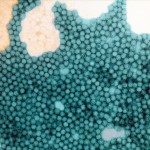Link to Pubmed [PMID] – 8523541
J. Virol. 1996 Jan;70(1):305-12
Most poliovirus (PV) strains, such as PV type 1/Mahoney, cannot infect the mouse central nervous system. We previously identified two determinants of mouse adaptation of PV type 1/Mahoney at positions 22 and 31 of the viral capsid proteins VP1 and VP2, respectively (T. Couderc, J. Hogle, H. Le Blay, F. Horaud, and B. Blondel, J. Virol. 67:3808-3817, 1993). These residues are located on the interior surface of the capsid. In an attempt to understand the molecular mechanisms of adaptation of PV to mice, we investigated the effects of these two determinants on the viral multiplication cycle in a human cell line. Both determinants enhanced receptor-mediated conformational changes leading to altered particles of 135S, one of the first steps of uncoating, and viral internalization. Furthermore, the residue at position 22 of VP1 appears to facilitate RNA release. These results strongly suggest that these determinants could also facilitate conformational changes mediated by the PV murine receptor and internalization in the mouse nerve cell, thus allowing PV to overcome its host range restriction. Moreover, both mouse adaptation determinants are responsible for defects in the assembly of virions in human cells and affect the thermostability of the viral particles. Thus, these mouse adaptation determinants appear to control the balance between the viral capsid plasticity needed for the conformational changes in the early steps of infection and the structural requirements which are involved in the assembly and the stability of virions.
